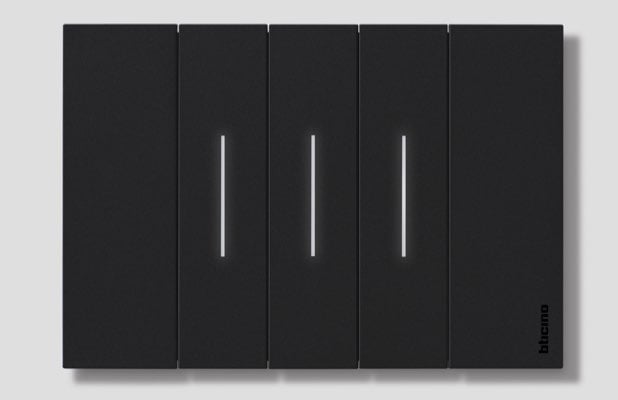Author: Editorial board

Developments in the lighting sector: a chat with Enrico Pianezzola
We interviewed Enrico Pianezzola, Project Manager of Bticino's Living Now line, to discuss some of the trends in the lighting sector relating to the residential installation sector.
How is the residential installation sector evolving? In which direction is the company moving? In this article, Enrico provides us with an in-depth look at the projects of Bticino, a renowned brand of the Legrand group with an all-Italian soul, which were also developed in collaboration with SLIM.
More specifically, we will be looking at: :
- Bticino: an overview of the company
- Developments in the lighting sector
- The collaboration between SLIM and Bticino
If you want to keep up to date with the latest news about SLIM and its light signalling products, click the button below and subscribe to our newsletter!
Bticino: an overview of the company
Good morning Enrico, before starting our interview, can you tell us about your role in Bticino?
My professional career has been linked to Bticino since the 1990s, when I started my career as a designer in the civil sector and, in particular, I was involved in residential installation, one of the key sectors for our company. My role has evolved over the years: I became Project Leader, a position in which I was responsible for the implementation of entire residential projects. Later, in January 2022, I became Head of Civil Product Development for Bticino. My division is made up of 33 people including designers, production managers, dimensional control and project quality technicians.
What projects are you working on?
One of the latest projects is the Living Now line, the premium civil series that has been very successful not only in Italy but worldwide. The line has been exported to several European countries (France, Belgium, Spain, Greece, Turkey, Russia) and also overseas (Mexico, Chile, Peru, Brazil, India, Australia, China), receiving appreciation that has gone beyond the most optimistic forecasts in terms of volumes and quantities. Alongside this successful case, I also followed the release of specific projects in the field of civil installation: we have focused on aluminium, glass and stone plates for the Axolute range and the Màtix range.

How has the lighting sector changed in recent years?
The great novelty of recent years in the lighting sector, from the point of view of civil installation, concerns connected installation. Bticino has always had two types of installation in its catalogue: traditional historical and domotic/home automation systems, which required a special system, completely different from the traditional one. The installation of home automation systems was considered a niche due to the technical specificities required for management. The company has invested consistently over the years to evolve the products in this direction to change and modernise the residential installation.
With Living Now, Bticino has launched the intelligent, smart, easy-to-use connected system, combining the installation system of a traditional system with the advantages of a home automation installation.
The new line of natively connected devices offers the possibility to integrate multiple systems, remotely control lights and sockets and, at the same time, monitor consumption in a way that is simple for both the user and the installer. Today, Italy is the first European country for connected installations in the civil world, and this is an important fact. Our country has acknowledged this new trend and is working towards customising lighting systems, while in other countries, this functionality remains more standardised.
In your opinion, what are the industry trends of the moment?
From an aesthetic point of view, the trend is towards devices with increasingly smooth, flat and minimal shapes. There is a tendency to prefer monochromatic, neutral colours that contribute to a perfect integration between the architecture of the environment in which the device is to be inserted, the light and the design.
From a structural point of view, starting with the choice of materials and the product manufacturing processes, we see a strong orientation towards the green economy that implies major changes in industrial processes and design of the final application.
Speaking of sustainability and lighting, what innovative aspects do you see for the future?
Sustainability is a key issue for Bticino and the entire Legrand group. In this context, our company has set itself rules and objectives to be achieved by 2024, which include bringing the sustainability issue into all projects under development. This commitment requires action on all fronts, starting with reduced use of plastic and metal materials and the introduction of recycled plastic materials or materials that come from a virtuous cycle of circular economy, but not only. The focus on this issue requires rethinking the complete life cycle of each product: each individual component must be easy to disassemble and separate so that it can potentially be reused on the market for other functions or even within the company itself. This new trend, strongly supported by the Group, is aimed at minimising the environmental impact of our company.

In this sense, the world of Research and Development is looking to the future, to new materials to replace plastics. Today, there are plastics on the market that derive from the mechanical recycling of the recovered materials themselves: these materials have slightly inferior mechanical and technological characteristics compared to those of first quality, but can be used in specific situations. Another type of innovative material concerns biobased plastics: they are not made from oil, but from other natural elements and, therefore, do not produce the same CO2 consumption effects as they are made from a renewable source. For example, polycarbonate can be obtained from the synthesis of lignin, a material derived from wood, a renewable source.
The latest generation of materials of this type comes from Japan. These are materials of bacterial origin that have the appearance and transformability of a plastic material.
A new generation of recycled materials is also appearing on the market: materials produced by chemically recycling plastic. In this case, the plastic is no longer recycled mechanically but chemically, broken down into monomers that generate the polymers to obtain top-quality plastics.
Bticino has an ongoing partnership with SLIM: can you tell us why you decided to turn to SLIM? In your opinion, what are the strengths of this partnership?
The partnership between SLIM and Bticino is solid and based on shared values such as excellence, innovation and Made in Italy quality. We have always relied on SLIM to supply switch signalling devices for various lines. SLIM's main strengths are its flexibility and responsiveness; there has always been a direct and collaborative relationship between the parties, which has allowed us to get the most out of the end result. The ability to respond quickly and the willingness to take on all design requests, from the most technical to the definition of the best aesthetic solution, are undoubtedly added values that made us choose SLIM for the development of lighting projects.
Let's talk specifically about the collaboration on Living Now, the latest generation of natively connected plates. What was the request you made to SLIM?
Specifically, we worked with SLIM to backlight the inverters, a specific function of the electrical installation that has complex mechanical characteristics. We needed the project to be taken on within a tight timeframe and to be provided with the most appropriate solution. We approached SLIM aware of their skills and with specific requirements. The quality of the lighting we wanted to achieve had to match the characteristics of the light we had already developed, even though it was introduced in a completely different mechanism. Subsequently, the need arose to have different types of LEDs available: one white and one blue. Once we had defined the circuit, colours and light intensity, we asked them to assemble the parts. SLIM was able to fully satisfy the design request, providing us with a component that lived up to the expectations and quality of the line with its innovative design and refined finishes.
We would like to thank Enrico Pianezzola for this valuable contribution.
Would you like to know the basic steps for designing custom lighting fixtures with us? Click on the button below and find out the 7 most frequently asked questions about designing lighting devices.
